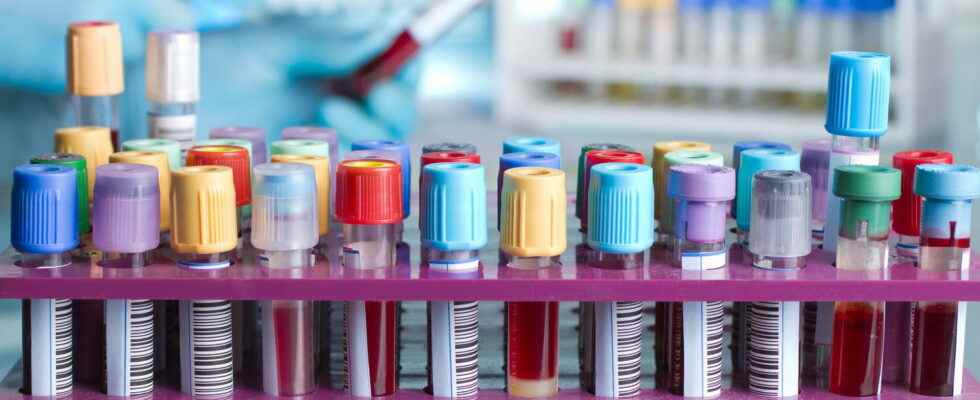What are the compatible blood groups in case of transfusion or pregnancy? Blood groups define categories of individuals according to the variety of antigens and antibodies present on red blood cells. There are several classifications, the main ones being ABO and Rhesus (Rh).
The composition of blood is the same for all humans, but the antigens found on blood cells – erythrocytes (red blood cells), leukocytes (white blood cells), thrombocytes (platelets) – and certain plasma proteins such as immunoglobulins vary from person to person and define blood groups, among other things.
The ABO system, which classifies the different blood groups, was discovered in 1900 by Landsteiner. Those blood groups are four in number (A, B, AB and O) and are differentiated by the presence, absence or combination of A or B antigens on the surface of red blood cells.
There are three types of antigens A, B and AB and four blood groups. Group A has only A antigens on the surface of red blood cells (and anti-B antibodies) group B only B (and anti-A antibodies), group AB has both types of antigens but no antibodies . Group O is characterized by the absence of these two types of antigens and the presence of both antibodies.
| Group | Antigen on the red blood cell | Antibodies in serum |
| AT | A or (A and O) | anti-B |
| B | B or (B and O) | anti-A |
| AB | A and B | no antibodies for the system |
| O | O | anti-A and anti-B |
A child’s blood type is based on that of their parents. It is indeed defined in relation to the group of its parents, which is based on two alleles. Below is the table showing the different possible combinations. In France, the most common blood group is group A (45%), followed by groups O (43%), B (9%), and AB (3%). Each individual receives two alleles A, B or O. The alleles A and B are dominant and the allele O is recessive: the latter can only be expressed in the presence of a second allele O.
- A child of group A may have inherited one A allele and one O allele, or two A alleles.
- A child with blood group B may have received one B allele and one O allele, or two B alleles.
- To be group AB, you must have the A allele and the B allele (co-dominant).
- Group O subjects must have received two O alleles.
The parents being themselves carriers of two alleles, 78 combinations are possible in theory according to the genotype of father and mother. This explains why parents from group A can have a child from group O, for example. There are also very rare blood groups resulting from abnormalities, such as the “Bombay” type blood group.
A blood group is rare when less than one person in 250 is compatible with it in the general population. For example, there are subjects who are neither A nor B, neither AB nor O: their blood group is called “Bombay”. He is exceptional.
Another classification is used to categorize blood groups. This is the rhesus factor which can be positive or negative. This factor depends on the presence or absence of another antigen on the surface of the red blood cells. We add a + in case of presence of this protein to the letter of the blood group and a – in case of absence. Other subtypes are also described, but less predominant (Kell, Duffy…). The rhesus factor is also transmitted genetically: the Rh+ allele is dominant and the Rh- allele is recessive. It is therefore mandatory to have two RH- alleles to be a negative blood group. People with a positive blood group have two Rh+ alleles or the combination of Rh+ and Rh- alleles.
The Rhesus factor is of great importance for Rhesus negative women who wish to have a child and whose partner is Rhesus positive. There may be what is called a “rh incompatibility“. Rhesus immunization occurs during the first pregnancy and the woman will develop antibodies during the second pregnancy, which are dangerous for the child.
The importance of knowing your blood group comes from the fact that in case of need for transfusion, the blood received must be compatible with yours. Antibodies and antigens of the same type must not be brought into contact at the risk of causing rejection or coagulation of the blood which can be fatal. Yes, for example, the recipient’s anti-A antibodies bind to the A antigens red blood cells from the donor, they cause theagglutination of these cells, even their destruction (haemolysis). This causes thetransfusion failure and, in some cases, very serious clinical reactions. This is why, during a transfusion, the compatibility between blood groups must absolutely be respected.
People in group O- are “universal donors”, because all other groups can receive their blood since it does not contain any antigens but only receive blood from people of the same group.
People in group AB+ are “universal recipients” and can only donate blood to group AB+.
The blood group is determined during a routine blood test or during blood donations. It is advisable to carry a blood group card with you in the event of an accident, even if the determination of the blood group takes place before each transfusion. The determination of the group and the rhesus factor is made at the beginning of each pregnancy and before any surgical intervention.

